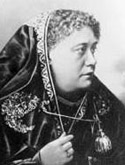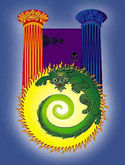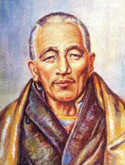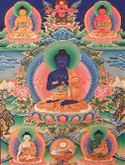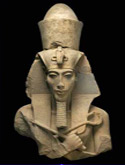Jeddu Krishnamurti: Sage, Teacher of Spirituality
(1895-1985?) May 12, 1895, Madanapalle (Madras) India, 12:25 AM. (Source: Sabian Symbols.)

(Ascendant, Aquarius; Sun, Mercury Taurus; Moon, Sagittarius; Venus and Neptune conjunct Pluto, all in Gemini; Mars and Jupiter in Cancer, conjunct; Saturn and Uranus in Scorpio.)
 Jeddu Krishnamurti was one of the twentieth century’s best known teachers of spirituality. He was personally cultivated at an early age by C.W. Leadbeater and Annie Besant (two leading figures in the Theosophical Society). In their eyes, he was to become the “World Teacher” and, indeed, for a brief period, so we are told, an experiment was undertaken wherein the true World Teacher and Head of the Spiritual Hierarchy, the Christ, overshadowed the boy and attempted to work through him. It was during this period that the book, At the Feet of the Master was produced.
Jeddu Krishnamurti was one of the twentieth century’s best known teachers of spirituality. He was personally cultivated at an early age by C.W. Leadbeater and Annie Besant (two leading figures in the Theosophical Society). In their eyes, he was to become the “World Teacher” and, indeed, for a brief period, so we are told, an experiment was undertaken wherein the true World Teacher and Head of the Spiritual Hierarchy, the Christ, overshadowed the boy and attempted to work through him. It was during this period that the book, At the Feet of the Master was produced.
But Krishnamurti, for various reasons, became increasingly dissatisfied with his Theosophical mentors, and with his own Theosophically related activities, and during a crisis period broke from them and began thinking and teaching in an entirely new way. For the rest of his life he pursued this radical departure from his early Theosophical roots, becoming known throughout the world for his insistence that spiritual aspirants should think for themselves and approach divinity without pre-conceptions and without dependence upon the Masters or even upon spiritual teachers – such as themselves. He seemed to revert to his own version of the ancient Vedanta, which considered the ego illusory and the mind simply the source of illusion – however much that mind was used to prove its own illusory nature.
As his life advanced, Krishnamurti developed a world following (something essentially against his own philosophy of spiritual independence). Near the end, he had disciples in many countries, and even within the United Nations Organization, some of the leaders of which referred to him as the “World Teacher”.
The chart of Krishnamurti (and of other such developed souls) can be read confidently in an esoteric manner, using esoteric rulerships and, in some cases, hierarchical rulerships. The major signs involved are Aquarius Taurus, and Sagittarius – his Ascendant, Sun and Moon Sign respectively.
Here Taurus is definitely the sign of illumination which arises when the illusions of mind have been defeated. Interestingly his Taurus Sun is placed in the third house where the customary thinking processes of the mind are symbolized. Krishnamurti was a powerful thinker and reasoner (the close semi-sextile between Mercury in Taurus and Venus in Gemini must be effective, with the Moon in Sagittarius contributing the philosophical impulse, and remembering how many famous philosophers have had strong Taurean energy). It was as if he followed Ramakrishna’s dictum: “the mind is like a thorn; use the thorn to remove the thorn, then throw them both away”. He thought intensively in order to prove the worthlessness of the usual thought process, calling the mind “just a bundle of memories”.
In his inherently Vedantic approach, Krishnamurti was, perhaps, even more uncompromising than the Buddha, attempting in his teaching to destroy all attachments to the possessions of consciousness. In this we must remember that Taurus, on the lower turn of the spiral, seeks to have, thus preventing its own freedom. Using the first ray, Krishnamurti rigorously separated the perceiver from the contents of consciousness, without ever referring specifically to the authority of any ancient doctrine (thus displaying the non-traditionalism of the Aquarian)
His Ascendant, Aquarius, signals his resonance with a New Age offering the possibilities of new (yet anciently based) spiritual approaches, and the tremendous effect he has had upon those who are sensitive to the new vibration. There is a close connection between Aquarius and Alcyone (the “Star of the Individual”, the central star of the Pleiades, visually part of the constellation Taurus, and considered to be “in” the sign in which Krishnamurti was born). In fact, in early days, Krishnamurti was known as “Alcyone” and a book was written, The Lives of Alcyone, which purported to describe about fifty of his past incarnations, dating back some fifty thousand years. Perhaps this identification with the “Star of the Individual” can explain his insistence upon spiritual self-reliance.
In the book, The Initiate in the Dark Cycle, by Cyril Scott, Krishnamurti was said (by one of the Masters) to have been passing through the Arhat Initiation (the fourth), at which time, according to the Tibetan’s teachings on esoteric astrology, both Taurus (via Vulcan) and Aquarius (most often the sign of the last physical incarnation) can be powerful. He certainly possessed the power rigorously to destroy illusion conferred by illuminative Taurus, and necessary for those who are to pass through this fourth spiritual step. He was, as well, from the nature of his life, essentially, a renunciant and seemed to abide in a state of “Isolated Unity” even when surrounded by crowds. Further, his life reflected an Aquarian synthetic summation characteristic of those focused upon the freedom from the fourth kingdom to be found at that degree.
Without attempting to be entirely specific, Krishnamurti’s rays seem to have been (from the spiritual perspective) principally the second and the first (both of these radiating from levels “above” the personality – though the first ray may be found within the personality as well), with some fourth ray within the personality or its vehicles conferring imagery, appreciation of beauty and intuition. The sixth ray of devotion was also present – in the early days. He undoubtedly began his life with a second ray focus. and the “overshadowing experiment” would require this ray if he were to resonate with the second ray quality of Maitreya, the Christ. His early statements and his first book are filled with the quality of the Ray of Love-Wisdom.
After he dissolved his Theosophical associations, however, his ray focus seemed to change, and far more of the first ray entered. He was still and ever the teacher (and so the second ray certainly did not disappear) but his teaching grew increasingly demanding and austere. Even if he remained upon the second ray in his soul, there are essentially three different ways to express upon this ray – the way of the occultist (the third sub-aspect of the second ray), expressing occult knowledge in meticulous detail; the way of pure love (the second sub-aspect) which is the Christ’s way; and the way of wisdom – the Buddha’s way, which expresses the first sub-aspect of the second ray (cf. DINA II 518) He seemed to choose this latter approach which resonated closely with the essentially first ray philosophy of the Vedanta of which he became an active exponent without categorizing or labeling his teaching. At Krishnamurti’s stage of development, however, the influence of the monadic ray would also become a factor, and one could debate whether the monadic quality was the first, or whether the subray of the monad was the first. Before jumping to conclusions, must be remembered in this regard, that the Buddha expressed His second ray along the wisdom line (and hence upon the first sub-aspect of the second ray), however, the Buddha was a third ray monad. The change in the quality of Krishnamurti’s teaching was obviously towards a more first ray coloring, but caution must be used in assigning the source of that quality.
The chart is rich is fourth ray potentials as well. The Sun and fourth ray Mercury are placed in fourth ray Taurus; Saturn and Uranus are found in fourth ray Scorpio; and the fourth ray Moon is place in Sagittarius (with its own fourth ray component). This would be an important ray for Krishnamurti, given his initiatory process and life purpose. Undergoing the fourth initiation requires the use of the fourth ray, the ray which “rules” this initiation. As well, every Arhat must contact the fourth kingdom (humanity) in a new, constructive and liberating way. Obviously, by numerical resonance, one can more easily relate to the fourth kingdom as a whole, if the fourth ray is present. This ray may well be influential in Krishnamurti’s personality and/or lower mind, and certainly he employed it in his essentially intuitive and buddhi approach – for the plane of buddhi or of intuition is the fourth. Buddhi Mercury in Taurus and the Moon in Sagittarius (on of the intuitive signs) would certainly enhance the power of the intuition.
From a planetary perspective, transformative Uranus is powerful as the exoteric ruler of the Aquarian Ascendant, and Uranus is placed in the ninth house. Krishnamurti did, in fact, cause a revolution (Uranus) in higher thought (ninth house) and in philosophical perception. Uranus is found is destructive and transformational Scorpio, and opposed to the “seeing” Sun in Taurus. This is a very strong and powerfully first ray aspect because of the Vulcan rulership of Taurus and the Pluto rulership of Scorpio. It was not to be expected that Krishnamurti would simply “go along” placidly (initial Taurus) with his early education. He would think for himself and cause a dramatic disturbance (even a revolution) within the Theosophical Society.
Saturn, too, is placed in Scorpio in the ninth house, so he squarely faced (Saturn) what he perceived to be illusions of thought and then did all he could to transform them (Uranus). He purpose was to evoke the emergence of light (Taurus and Vulcan), the intuitive illumination of the mind. The exoteric ruler of Taurus is Venus in Gemini (of which Venus is the esoteric ruler). This placement relates to the use of the antahkarana, the “rainbow bridge” which connects the personal consciousness with the vaster, intuitive and impersonal awareness of the Spiritual Triad. The placement of Venus in the fifth house of “causal expression” (wherefrom the accumulated qualities and faculties of the causal body are accessed and revealed), shows that he could easily draw information and content (Gemini) from his own “treasury” (the causal body), for Venus symbolizes this vehicle and the accumulated personal/transpersonal knowledge which there resides.
Jupiter (the esoteric ruler of the Aquarian Ascendant) is an important planet, conjunct Venus (and thus indicating an abundance of soul gifts) and conjunct Mars-Jupiter and Mars being in Cancer. Jupiter is placed at just about the midpoint between Venus and Mars. Jupiter is the planet of wisdom and distributes the second ray. These three together suggest as relationship between the solar plexus center (Mars), the heart center (Jupiter) and the ajna center (Venus). It is clear that Krishnamurti was in individual with deep and sometimes disturbing emotions, but this agitation was lifted up into the light and love of wisdom, represented by Jupiter and Venus. Interestingly, it is said that the problem of sex (and let us note that these planets are found in the fifth house) is solved at the fourth initiation. Certainly, Venus and Mars are the archetypal female and male – Venus in the sign of the “angels” and Mars in a sign associated with the lunar lords. The conflict is present (for the fourth ray is strong in Krishnamurti) and it is resolved by a fulfilled wisdom (second ray Jupiter in Cancer). With Jupiter in the position of is exaltation, there is always a fulfillment to be experienced. This fulfillment can be of the form or of consciousness. These three planets have much to do with Krishnamurti’s work as an educator – of the “younger generation” – fifth house.
With respect to this fifth house, it is a major field of self-reliance, and points to the authenticity of Krishnamurti’s later teachings – derived and expressed not from doctrine, but from his own resources of consciousness.
The Venus opposition to the Sagittarian Moon is worth noting, for it places the symbol of the soul, Venus, in opposition to the symbol of the lunar lords (the Moon) which, interestingly, is placed in the sign rules the Creative Hierarchy of Lunar Lords. In this opposition we see a re-accentuation of the soul/personality contrast to be seen in Venus and Mars. Mars and the Moon are, from certain perspectives, equivalents, and both are closely related to the irrational lunar vehicles. Venus redeems the Moon, just as the “angel” (Gemini) redeems the “animal” (Sagittarius). The lunar lords must be completely conquered at the fourth initiation, and this Venus opposition to the major symbol of these lords is a factor in the conquest. The mediated relationship between Venus and Mars is another.
The Neptune/Pluto conjunction (found in the charts of a number of Nazis born at the same period, and used to perpetrate illusion and bring about the death of true thought, are here used to destroy the foundations (fourth house) of illusion. Glamor and illusion combine to create the prison in which the modern human being is enmeshed. This inherently destructive combination destroys (Pluto) and dissolves (Neptune) old thoughtforms, and clears the way for new perceptions of truth related to Krishnamurti’s revolutionary Uranus in the house of higher thought.
For an initiate of the third degree in process of becoming an Arhat of the fourth degree, hierarchical rulers may be seen as important. The Sagittarian Moon is the hierarchical ruler of the Aquarian Ascendant, emphasizing the need, at the fourth degree, to completely subdue the Moon (ruled by the number four), so that all four of the lunar vehicles can become instruments for the expression of the threefold Triad and their source, the monad.
The star aspects are also worth noting though it is not possible to enter in detail all interesting factors in relation to this chart. Buddhic, reasoning Mercury is indeed conjunct the star Alcyone, “the Star of the Individual”, accounting, at least partially, for the major theme of independence which resounds in Krishnamurti’s teaching. Mars is conjunct Sirius (the “Scorcher”) contributing to some of his fiery, purificatory experiences. Jupiter (the esoteric ruler of the Ascendant) is conjunct Mirzam (the “Announcer”), magnifying the awakening effect of his message. His powerful Uranus is closely conjunct to Zuben Elschamali, which has been called the star of “Negative Social Reform”, emphasizing that attempts at reformation are undertaken without consultation or without regard for the needs of society. When one thinks of the shocking effect of his teaching (especially upon Theosophists) this star position seems to have significance. However, the Ascendant is parallel within one minute of arc of a companion star in Libra, Zuben Elgenubi, the star of “Positive Social Reform”, balancing the picture. That Krishnamurti was interested in reform, and especially of consciousness, is undisputed. There are other interesting star positions which bear examination.
It is tempting to take an exhaustive approach to this chart, which, unfortunately is beyond the scope and purpose of this present volume of Tapestry. For those who are interested in a fine astrological analysis of Krishnamurti and his life process, we would recommend the excellent work of the astrologer Phillip Lindsay, who has entered these matters in great depth. See “The Initiations of Krishnamurti: An Astrological Biography“.
Krishnamurti used both the first and second rays to help create the new, Aquarian human being. He applied great will and wisdom to accomplish an essentially Aquarian transformation.

